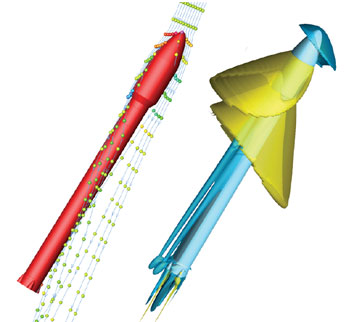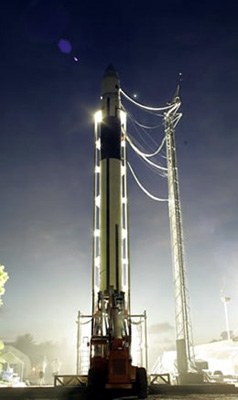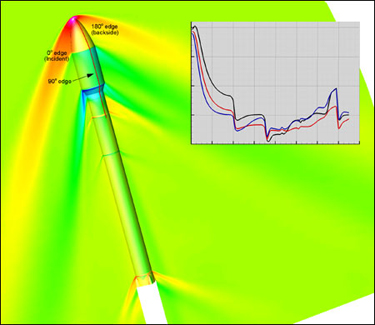 Contributed by Michael Colonno
Contributed by Michael Colonno
SpaceX
The Challenge:
Successfully Launch a Rocket Into Space
Designing, building, and successfully launching a rocket into space is no easy endeavor. NASA and other foreign space agencies have accomplished such feats through the hard work and determination of hundreds of thousands of engineers over many years with significant government financial support. Taking on this task as a small privately funded company is an even bigger challenge.
The Researcher
Michael Colonno is the chief aerodynamic engineer at Space Exploration Technologies, an El Segundo, CA-based company that is developing a family of launch vehicles that will be used to transport both private and government spacecraft into space, from low Earth orbit to geosynchronous orbit to planetary missions. The mission of the company is to reduce the cost and increase the reliability of access to space, ultimately by a factor of ten.

Falcon 1 on Omelek Launch Pad
The Solution: Reducing Cost While Improving Reliability
The company is designing and building the Falcon family of rockets from the ground up, including two new liquid-fueled engines, primary structure, avionics systems, and guidance and control software as well as the ground support equipment. The company’s rocket payloads will include both commercial and government satellites -both U.S. and foreign.
In early 2006, Space Exploration Technologies plans to launch its first rocket, the Falcon 1 with a payload funded by the Defense Advanced Research Projects Agency (DARPA), the central research and development organization of the U.S. Department of Defense.
The company is now in the active design phase for its much larger follow-on generations of rockets, the Falcon 5 and 9. While the Falcon 1 has a reusable first stage and expendable upper stage, the next-generation vehicles may reuse both stages in certain applications.
Engineers at the company are using an in-house CFD code to look at shapes and concepts for the Falcon 9. The results of the simulations will help guide engineers as to how improve and optimize the vehicle’s overall aerodynamic performance by lowering drag and loads on the vehicle. The CFD solver is being run on an eight-machine, 16-processor cluster of Dell Blade servers running Linux.
New Design, New Issues to Resolve
Besides being larger in size than the original design, the Falcon 9 will also feature a fairing (leading portion of the vehicle that houses the payload) that is larger in diameter than the rest of the vehicle. Regarding the larger fairing, Colonno says, “what you can get when you have a shape like that is a separated region of flow behind the fairing. Often you’re shedding vortices or you have a large low-pressure wake, things you want to avoid, if possible, because they lead to high steady and unsteady loads on the rocket.”
In order to look closer at the effect of the larger fairing on the vehicle as a whole as it travels through the Earth’s atmosphere and through a simulated space environment, Colonno uses Tecplot software to visualize the CFD results. In order to prove out the vehicle’s proposed design, Colonno simulates the structure in the most hostile of aerodynamic conditions.
The plot shows the pressure coefficient (Cp) and Mach (M) contours of Falcon 9 at maximum dynamic pressure, one of the most severe aerodynamics loading conditions. The plot’s stream traces clearly illustrate 3D, viscous, turbulent CFD solutions. “With a row of stream traces in front of the vehicle, you can see this sort of vortex on the back or top side of the vehicle, as seen from the flow direction,” says Colonno. “That can sometimes be a red flag. We’re looking for separated flow and vortex shedding, and you can only really see that with good visualization in 3D.”
Colonno, who has used Tecplot software for a year and a half, says that this part of his job would be hard to do without Tecplot. Colonno uses Tecplot to create 3D contour plots as well as 2D X-Y plots to look at pressure or temperature versus distance around or along the vehicle. Plots, like the one shown here, are used to generate structural loading on the vehicle and to compute lift and drag.

Pressure coefficient (Cp) contours of Falcon 9 with surface Cp plotted along the incident, 90-degree, and leeward edges of the fairing. This data serves as the basis for steady aerodynamic load computations.
Tecplot Helps Understand the Complex
Understanding the complex phenomena behind the flow features of the vehicle would be nearly impossible without Tecplot’s visualization capabilities. While custom post-processing software is another option, Colonno doesn’t believe it’s generally a good one. “Even if someone handed me a good code for identifying and isolating complex flow features, I don’t think I would trust it because it’s a very, very difficult thing to come up with an absolute criterion for,” says Colonno. “Personally, I think that visualization is the best ways to find these types of flow features.”
The benefits of using Tecplot are twofold, according to Colonno. Since even the best CFD solvers sometimes diverge or simply don’t fully converge, being able to quickly identify if the run was accurate by visualizing the results is a huge benefit. “When I first get a solution out of the cluster, the number one thing is to be able to quickly determine whether that run is accurate,” says Colonno. “Am I getting the right flow features? Is everything going in the right direction? Are features like shock waves positioned correctly? I can open it up and in a few seconds I can see if it worked or if there was a problem.”
Another key benefit is the ability to quickly understand the complex phenomena behind flow features. Colonno says that Tecplot visualizations enable him to instantly identify large-scale or key flow features, which are essential to improving the aerodynamics of space-bound vehicles and would be much more difficult without visualization software.
Tecplot’s greatest strengths, Colonno believes, are the ease in which the software imports and exports data as well as its ability to quickly generate good visualizations for documentation. In order to help others within the company understand the complex flow features that impact the structural design of the Falcon rockets, Colonno says he often emails pictures created in Tecplot to co-workers.
Colonno believes that Tecplot is essential to his work at Space Exploration Technologies. “I don’t know what else I would do if I didn’t have Tecplot to visualize this data besides hacking up some code myself that would hopefully tell me if my solutions were accurate or not.” Besides providing valuable insight, Tecplot offers quantifiable benefits as well. “I would say that Tecplot software definitely saves us a lot of time and therefore money,” says Colonno.




